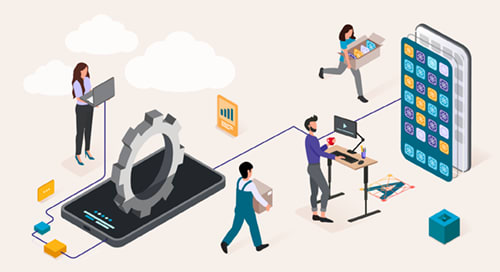APIs are the essential the building blocks that developers rely on to create today's compelling user experiences. But developers face a choice. Do they use an API from an external provider? Or do they decide to build their own? Either way, it's important to note that the role of API developers has evolved considerably in recent years and, whether they produce an API themselves or not, they are on the hook to design and package every API in a way that encourages greater adoption and reuse by API consumers inside and outside of their organization.
This guide takes you through four key milestones to understanding what will keep you on a steady track to creating more compelling API products:
- The shift to viewing APIs as products
- The rising role of API product manager
- Building the right level of granularity and support in API products
- Business leadership in design, management and value creation
What is an API product?
Packaging business-level capability
An API product, like any other product, can be defined as the packaging of a business-level service as a comprehensive unit of value that will be supported by your company. It may be comprised of several lower-level technical APIs and will contain things like business-level documentation, technical documentation, information about service levels, relevant usage plans, support and use cases (with examples), and an ability to transmit feedback. Information on onboarding, subscription, and security should also be included in the product package.
The rising role of API product manager
Merging technical expertise and business savvy
The best way to design an API product is to think about the target API consumer and what they would need to quickly discover, understand, test, and implement your API product. This requires knowledge of the audience and the digital business strategy your enterprise is following. Enter the individual with demonstrated business expertise and technical knowledge: the API Product Manager.
Just like any other type of product manager, an API Product Manager contemplates value creation, budgets, timelines, marketing, and packaging. They design dashboards, track adoption, and revise roadmaps based on what they learn in the market. Plus, they identify alpha and beta customers and conduct design sessions to make sure the product meets the needs of the target users.
API product granularity and support
Focusing on discrete API business services
This need for business-service-level access is further supported by the increasing number of API styles that are available. With the wider adoption of AsynchAPI, GraphQL, and gRPC in addition to REST and SOAP, the same information can be accessed in different ways for your advantage. But do you really need three different account balance API products based on your API style choice? Ideally, you'll want just one, with style options based on specific requirements.
Curating API products for easy discovery
Creating API products requires the right tools and a productization process that API product managers can use to build them. Curating an API product involves things like:
- Service level description and use-case documentation beyond the technical level API documentation
- Onboarding and subscription processes, including authorization and credential management
- Creating usage plans for direct monetization or internal chargeback
- Service level agreements with support contacts
- Sample code and sandboxes for testing
- Examples of other apps using the API product when available
- Collaboration capabilities such as rankings and messaging
Business leadership involvement
Linking API products to business initiatives
Line-of-business leaders or C-level executives such as Chief Digital Officer are the ones setting the business plans, goals, and initiatives that API products empower. Linking your API products to these business initiatives will be key to success. At the end of the day, a fruitful API initiative will involve a diverse mix of roles – solution architects, app development teams, business power users, and others. It will also entail a range of processes – from design, through prototyping, to go-live and usage.
Reporting and metrics need to be aligned to higher level business initiatives as well so you can observe exactly how your API products contribute to revenue and success. This is the concept of monetization and there are two main types, direct and indirect. Direct monetization is where you charge based on usage of an API (this can involve pricing plans with different tiers, rate limits, and SLAs).
Indirect monetization, on the other hand, associates API usage to the revenue of the initiatives it supports. That is, you track API usage to gauge engagement and adoption of your digital assets – whether you charge directly or not – which allows companies to charge-back the common infrastructure to the individual business units based on a fair set of metrics.
Start building an API digital product tier that can help you create more compelling API products










